As you take care of your garden, you may come across bright marigold flowers and watch their beautiful hues of yellow and orange flowers dance in the sunlight, adding happiness to your beloved landscape. The best news is that these flowers are relatively easy to cultivate, reseed, and flourish. But as pretty as they are, you might wonder, are marigolds edible?
Marigolds are popular edible flowers with a surprisingly unique citrus flavor and can be enjoyed raw in sandwiches or steamed like vegetables. Flower petals make great salad toppers or garnishes for added color and taste. However, it is essential to note that while marigolds are generally safe to eat, they contain compounds unsuitable for large consumption.

Marigolds make a popular choice when growing an edible backyard garden and are known for their vibrant color, having been used by cultures throughout history for decorative purposes. However, as this article demonstrates, marigolds have many uses beyond aesthetics.
In the Middle Ages, they were used in potions for predicting marriages. Marigolds were used to treat various conditions in the Caribbean, Chinese, and Peruvian folk medicine due to their medicinal properties. Through extensive research, I’ve gathered an all-encompassing guide to marigolds in this article for you to enjoy and benefit from.
Humble Highlights
- Uncover the rich history of marigolds in culinary traditions, their versatility in enhancing flavors, elevating visual appeal in dishes, and even their potential medicinal properties so you can benefit from these all-purpose flowers in the garden and kitchen!
- Save time by familiarizing yourself with the various marigold types and their suitability for consumption so you can confidently grow these beautiful blooms!
- Discover the edible parts of the marigold to fully maximize the benefits of this plant so you can enhance its flavor and reduce environmental waste.
Are Marigold Flowers Edible
Marigold flowers come in yellow, gold, orange, mahogany, and sometimes red or white. They originated from the American Southwest and Central/South America and were dispersed worldwide by early European colonists.
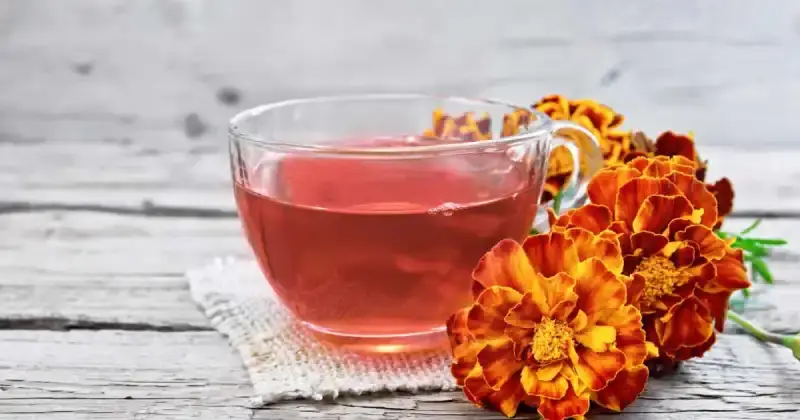
Marigold flowers are edible and have many culinary uses, adding flavor and visual appeal to dishes. The most common edible varieties are Tagetes erecta (African marigold) and Tagetes patula (French marigold).
Interestingly, ancient Egyptians considered marigolds a rejuvenating herb. Persians and Greeks also used its leaves and petals to make and enhance the flavor of their food. 1
However, verifying that the specific marigold variety you select is safe for consumption and has been grown without harmful chemicals is crucial. Flowers purchased from florists or nurseries may not be suitable for consumption as they might have been treated with chemicals not intended for human consumption.
Are All Types Of Marigold Flowers Edible
As explained above, marigold flowers have been used as edible plants for centuries. While not all types of marigolds are ideal for consumption, most varieties, such as the popular Tagetes erecta, are safe to eat in small doses.

Recently, marigold petals have been used as an ingredient in various dishes and herbal teas. Despite its popularity in cooking in many cultures, other marigolds, like pot marigolds or calendula, can taste somewhat bitter, making them enjoyable when eaten raw. 2
Marigolds have often been utilized mainly for their attractive blooms, being grown primarily for ornamental purposes. Still, they are becoming more commonplace in kitchen gardens due to consumers realizing that these plants can offer excellent flavor properties when used correctly.
Which Marigolds Are Edible
Most marigolds are edible, but it’s essential to differentiate between the various species and cultivars within the marigold family. The following are the most commonly edible marigold varieties:
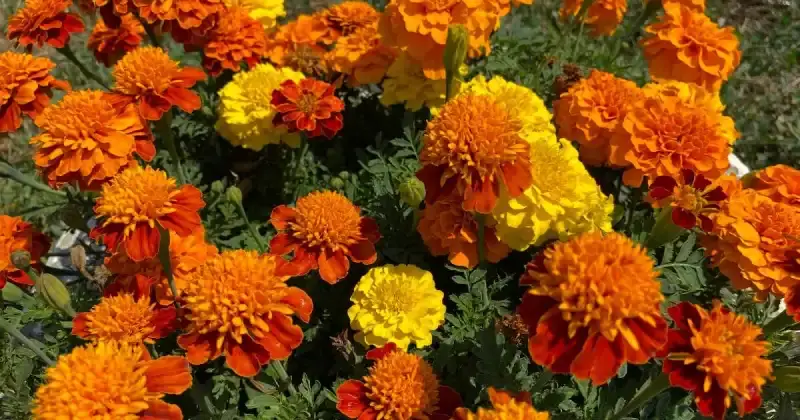
Pot Marigold (Calendula Officinalis)
In ancient Rome, calendula (Calendula officinalis), also known as pot marigold, had various uses. It was believed that consuming calendula could lead to interesting effects, such as the ability to see fairies, drowsiness, or increased feelings of love.
Romans incorporated calendula into their cuisine by mixing it with vinegar for salads, preserves, and seasoning meat. Additionally, they used the dried flower heads to flavor soups and utilized the flowers as a natural dye for cheeses or to add color to butter. 3
African Marigold (Tagetes Erecta)
Tagetes erecta, also called Mexican mint, Aztec, or African Marigold, is a wild marigold native to Mexico and Guatemala. It grows to a height and width of 3 to 4 feet (1 meter) and produces fragrant flowers that are 2 to 4 inches (5-10 cm) across. This plant has been used for centuries for various purposes, including as a beverage, dye, flavoring, and in traditional medicine.
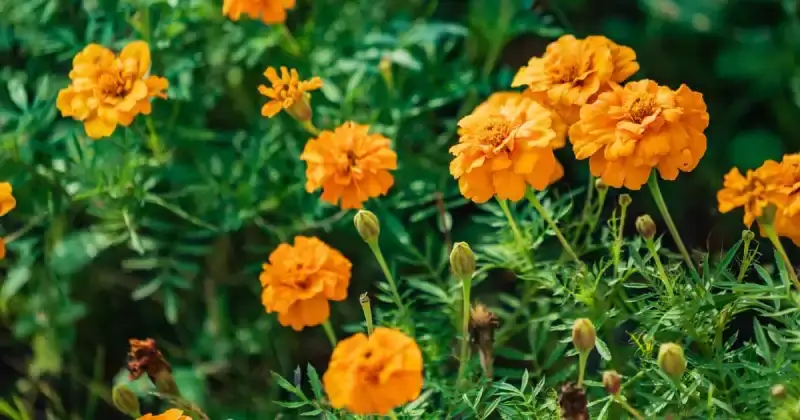
French Marigold (Tagetes Patula)
French marigolds, despite their name, are native to the Americas. French marigold flowers are edible and are currently being studied for their potential benefits to eye health due to their lutein content, which may help prevent age-related issues, including macular degeneration. They are also used as a natural feed for chickens to increase their lutein content and produce eggs with rich yellow yolks.
Signet Marigold (Tagetes Tenuifolia)
Also known as Gem, this variety of marigolds is an excellent addition to any garden. They have small, flat, daisy-like flowers smaller than other marigold types that set them apart. The foliage is very finely cut and fluffy, which creates an attractive soft border edge when planted along boundaries or in containers.
Signet Marigold is prized for its citrus and slightly spicy flavor. The small, delicate flowers are edible and make a delightful addition to salads, desserts, and drinks.
Mexican Tarragon (Tagetes Lucida)
Also called Sweet Mace, this marigold variety is often used as a culinary herb, particularly as a substitute for tarragon. Its leaves have a pleasant anise-like flavor, and the flowers can be used as a distinctive garnish.
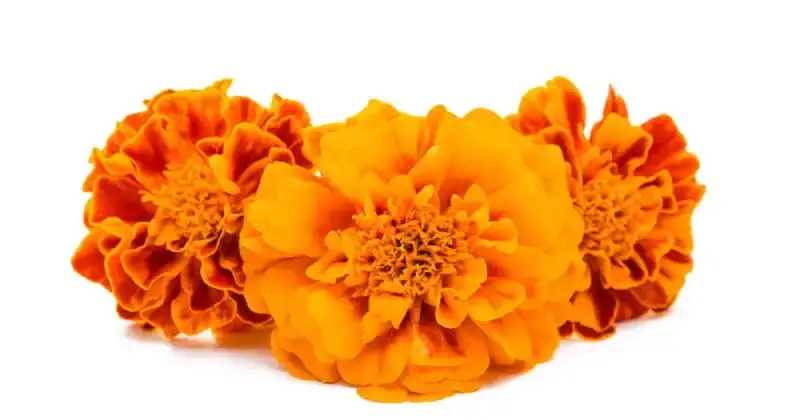
Wild Marigold (Tagetes Minuta)
Also called stinking roger, wild marigold is a fragrant and tall annual herb. It originated in South America but has spread as a weed to various temperate forests and mountainous regions worldwide. Tagetes minuta has been widely used by humans for its flavor and scent.
It is often found in cola beverages, alcoholic drinks, desserts, candies, other food items, and perfumes. The plant also has medicinal properties and is often used in cultural practices, depending on your location. 4
Which Marigolds Are Not Edible
Most marigolds are safe to eat. People worldwide have used various marigold species in traditional cuisines, teas, and herbal remedies. However, while most marigolds are edible and non-toxic, some marigolds’ taste might be less appealing for consumption, except for particular varieties.
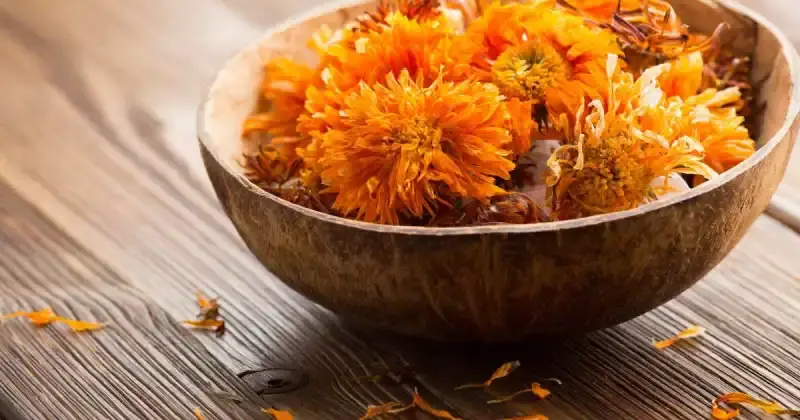
Additionally, several species of marigolds are biopesticides that can help repel pests, mosquitoes, nematodes, and fungi. Plant extracts used as insecticides are safer than chemical ones since they don’t hurt humans or animals and won’t pollute the environment. 5
As a result, some individuals may have allergies or sensitivities to certain marigold species due to their chemical composition. As with any new food or herb, it’s best to try a small amount first and observe how your body reacts. Always consult your doctor or health professional before consuming marigolds to see if you may be allergic.
Are Marigold Seeds Edible
Although marigold seeds are not detrimental to humans and animals, they may have a different taste or texture that could affect the flavor and quality of your dishes. Removing the seeds when preparing dishes or teas will prevent any bitterness or other undesirable characteristics in your food and beverages.
Check out this video below, which details how marigolds can be consumed. Whether raw, dried, crushed, or soaked, you can reap the tasty rewards of this versatile flowery bloom.
Are Marigold Leaves Edible
Marigold leaves are edible but not commonly chosen for consumption due to their pungent taste. However, they are safe to eat in moderation and not considered toxic. While marigold leaves are not widely used in cooking, some may creatively include them in certain dishes or infusions for potential health benefits.
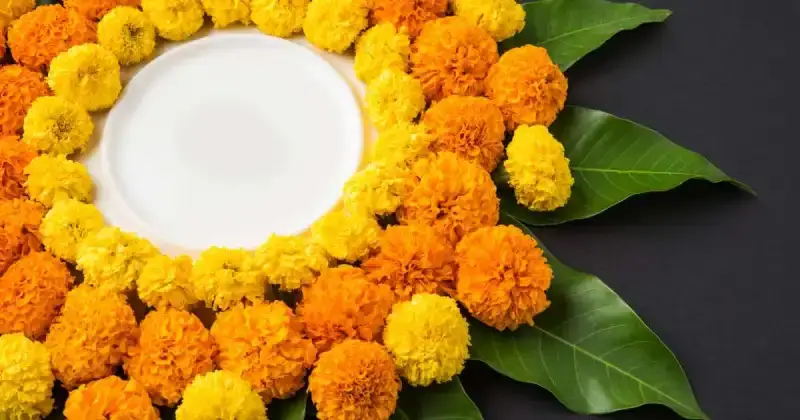
On the other hand, marigold flowers take center stage in the culinary world. Their vibrant colors, mild flavor, and pleasant aroma make them popular for enhancing the visual appeal of salads, soups, and other dishes. 6
How To Use Marigolds Edible Flowers In Your Kitchen
When Spanish explorers came to America, they found marigolds and thought it was a new discovery. But really, indigenous people had known about this plant’s culinary and medicinal benefits for centuries. Utilizing the edible flowers of marigolds in your kitchen can add a delightful touch to your dishes. Here are some creative ways to incorporate them:

- Garnish for Salads: Use fresh marigold petals to garnish green or fruit salads. The bright orange and yellow blooms will make your dishes visually appealing and the talk of your dinner party!
- Infused Oils and Vinegar: Add marigold petals to oils or vinegar to infuse them with a subtle floral flavor. Use these infused oils and vinegar in dressings or marinades.
- Herbal Teas: Fresh and dried marigold petals can be used to make herbal teas. Steep them in hot water for a soothing and aromatic drink.
- Butter or Cream Cheese Spread: Mix finely chopped marigold petals into softened butter or cream cheese for a unique and colorful spread on bread or crackers.
- Soups and Stews: Toss a few marigold petals into soups or stews before serving for an extra burst of color and flavor.
- Desserts: Decorate cakes, cupcakes, or desserts with edible marigold flowers. They will add an eye-catching element to your sweet treats.
- Ice Cubes: Freeze marigold petals in ice cubes to elevate the presentation of your beverages. 7
Also, remember specialized herbal butters. This simple and easy process is where you blend marigold petals with softened butter and herbs to create flavored herbal butter for cooking or serving with grilled vegetables.
A few additional tips when using marigolds in the kitchen:
1. Remember to use marigolds sparingly, as their taste can be rather intense.
2. Always ensure that the flowers are from pesticide-free sources and are suitable for consumption.
3. Before eating or adding marigolds to your dishes, cut off the base of the petals, which are usually white or pale green, as they tend to taste bitter.
How To Make Marigold Tea
To make marigold tea, use fresh, pesticide-free marigold flowers without seeds. Steep the flowers in hot water for 30 to 40 minutes, allowing the water to absorb their beneficial properties. After steeping, the marigold-infused water is filtered, leaving behind the marigold tea.
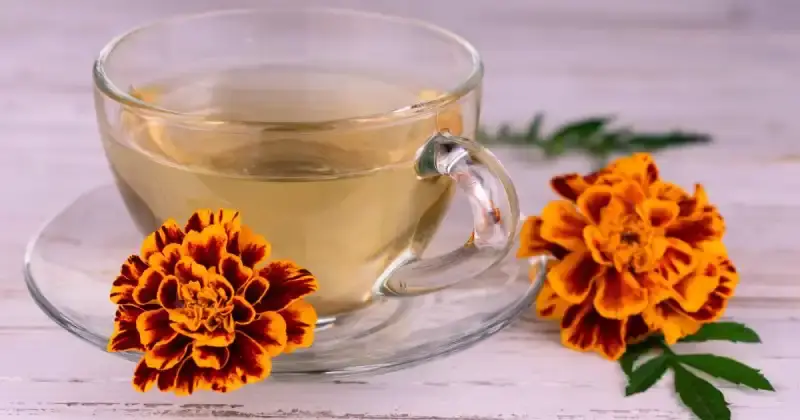
Optionally, honey can be added for a touch of sweetness. Recent studies have labeled marigold tea as an excellent antioxidant, antibiotic, and anti-inflammatory, making it a healthy and flavorful beverage option. 8
Be sure not to boil marigold flowers directly in the water. This activity could cause the antioxidants to evaporate and effectively “cook out” of your tea.
If you’re looking for all the reasons you should cultivate marigolds in your garden, hold up for just a second and check out the video below. It can help repel unwanted pests from your vegetable garden and soothe bug bites, aid in personal hygiene, and provide natural herbal medicine, among many other uses. Check it out below!
What Do Marigolds Taste Like
Marigolds have a unique and distinct taste that can vary depending on the variety and part of the plant consumed. The flowers of marigolds generally have a mild and slight citrus flavor with subtle hints of spice and bitterness. Some people describe the taste as similar to a combination of citrus and pepper.
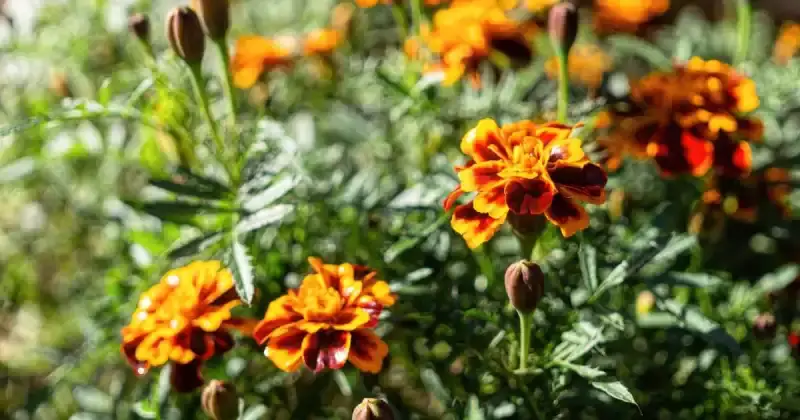
However, some varieties may have a more robust and unpleasant flavor. In particular, the leaves and stems of certain marigold types can be pretty bitter and are not commonly consumed as food. If unsure of the taste, it’s best to try a little first to see how palatable it is. 9
Health Benefits Of Eating Marigolds
Marigolds are rich in antioxidants. The petals contain carotenoid flavonoids, which help neutralize harmful free radicals in the body. These antioxidants can protect cells from oxidative stress and may reduce the risk of chronic diseases. Additionally, marigolds contain lutein and zeaxanthin, two carotenoids known to support eye health.

The anti-inflammatory properties of marigolds can help reduce inflammation in the body and may alleviate symptoms of inflammatory conditions such as arthritis and joint pain. Interestingly, during the Civil War, American doctors utilized its antiseptic properties to treat open wounds by packing them with marigold leaves.
Also, the vitamins and minerals found in marigolds, such as vitamin C and zinc, can boost the immune system, enhancing the body’s ability to fight infections and illnesses. Root extracts and hairy root cultures were discovered to have sulfur and citric acid. Furthermore, some compounds found in marigolds possess antimicrobial properties that can help combat certain bacterial and fungal infections. 10
Marigolds have a long history of medicinal use, treating conditions like angina, high blood pressure, cough, diarrhea, fever, inflammation, rheumatism, and food poisoning. In medieval times, monks prescribed marigolds for various ailments, including stomach cramps, bowel problems, liver complaints, insect bites, and snake bites. As with anything, before including these flowers in your diet, consult your doctor.
Conclusion
Edible flowers like marigolds offer a delightful blend of beauty and culinary potential. These edible flowers bring a refreshing citrus flavor to dishes, making them a perfect addition to savory recipes.
However, excessive consumption may not be advisable due to certain compounds present in the flowers. When used in moderation, marigolds can be a delightful and colorful way to elevate our meals’ visual appeal and taste.
Do you currently grow marigolds in the garden or use them in the kitchen? Drop us a line below and tell us what recipes you’ve created that have infused the incredible power of marigolds!
SOURCES
- National Library Of Medicine, National Center For Biotechnology Information – Nutritional Composition And Antioxidant Capacity In Edible Flowers: Characterisation Of Phenolic Compounds By HPLC-DAD-ESI/MSn
- MDPI – Edible Flowers’ Antioxidant Properties And Polyphenols Content Reflect Their Applicability For Household And Craft Tincture Production
- University Of Minnesota, Extension – Marigolds
- Wikipedia – Tagetes Minuta
- University Of Florida, Gardening Solutions – Marigolds
- ScienceDirect – Edible Flowers With The Common Name “Marigold”: Their Therapeutic Values And Processing
- ResearchGate – A Brief Study On Marigold (Tagetes Species): A Review
- The Washington Post – Orange Marigold Iced Tea
- Wikipedia – Marigold
- National Library Of Medicine, National Center For Biotechnology Information – Antioxidant And Skin Anti-Aging Effects Of Marigold Methanol Extract



